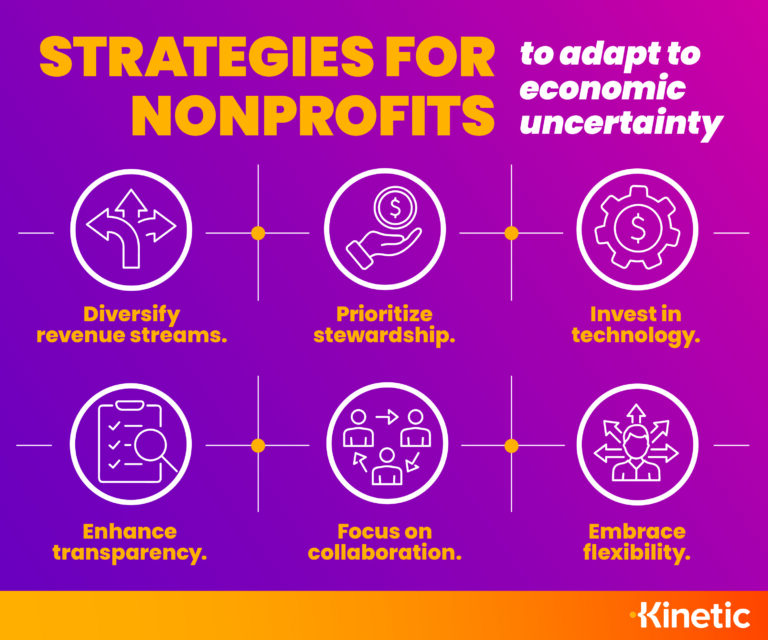In the nonprofit sector, adaptability is key. Economic uncertainty, shifting donor priorities and evolving community needs all require nonprofits to stay adaptable, innovative and mission-focused. While these challenging times can pose threats to fundraising and program sustainability, they also present opportunities for growth, creativity and renewed commitment to your mission.
Understanding the Impact of Economic Trends
As we move through periods of economic uncertainty, individuals and organizations often reassess their philanthropic priorities. Nonprofits may experience reduced individual donations, fluctuations in corporate sponsorships and tighter foundation funding. The 2024 Giving USA Report revealed that charitable giving in the U.S. has been impacted by inflation and changing financial conditions, with overall giving showing signs of slowing growth (Giving USA Foundation, 2024).
However, philanthropy doesn’t stop—it shifts. Donors continue to prioritize causes they care deeply about, especially those addressing urgent community needs. Nonprofits that demonstrate transparency, measurable impact and relevance are more likely to gain lasting donor trust, even during tough economic times.
Strategies for Nonprofits to Navigate Economic Uncertainty

1. Diversify Revenue Streams
Relying on a single source of income can be risky. Explore additional revenue streams like planned giving, peer-to-peer fundraising and corporate partnerships. Diversifying your income sources will help create a safety net during uncertain periods. Data shows that nonprofits with diverse funding streams are more likely to weather economic downturns successfully (Nonprofit Quarterly, 2023).
2. Prioritize Stewardship
Retaining existing donors is often more cost-effective than acquiring new ones. Strengthen relationships by showing appreciation, sharing success stories and maintaining regular communication. Let donors know exactly how their contributions are making an impact in real time. Additionally, research shows that retaining just 10% more donors can boost fundraising revenue by up to 200%, underscoring the significant impact that early and consistent engagement can have. (Nonprofit Quarterly, 2013).
3. Invest in Technology
Digital platforms are essential for connecting with supporters and streamlining operations. Use data analytics to track giving trends, personalize donor outreach and launch targeted campaigns. Tools like DonorPerfect and Bloomerang can help nonprofits adapt quickly to evolving circumstances and enhance donor engagement.
4. Enhance Transparency
Donors want to ensure that their contributions are making a real difference, especially during uncertain times. Provide clear, data-driven impact reports and updates on how funds are being allocated. Transparency fosters trust, which is particularly valuable when donors may feel cautious about donating. In a 2023 survey, 70% of donors reported that transparency was a key factor in their giving decisions (Charity Navigator, 2023).
5. Focus on Collaboration
Partnering with other nonprofits, businesses, or government agencies can help you maximize resources and expand your reach. Consider forming coalitions to tackle shared challenges or pooling resources for joint fundraising efforts. Collaborative partnerships increase your ability to meet your mission and attract new supporters.
6. Embrace Flexibility
Nonprofits that are willing to adapt their strategies—whether pivoting to virtual events, adjusting budgets, or reallocating staff—are better positioned to succeed. Encourage creativity within your team and remain open to testing new fundraising approaches. Organizations that adopted flexible fundraising methods saw a 25% increase in donor participation during 2023 (The Chronicle of Philanthropy, 2023).
The Role of Communication
Effective communication is the cornerstone of resilience. Share both successes and challenges with stakeholders and ask for their support when needed. Donors who feel like true partners in your mission are more likely to remain committed, even during tough times. Social media, newsletters and personalized donor calls are all excellent ways to maintain engagement.
Looking Ahead
Economic uncertainty may challenge nonprofits, but it also offers the opportunity to reassess priorities, strengthen donor relationships and innovate for long-term growth. At Kinetic, we’ve worked with organizations navigating these challenges and helped them develop creative solutions to meet their goals while staying true to their mission.
By focusing on resilience, transparency and collaboration, nonprofits can emerge from uncertain times stronger and more impactful than ever.

